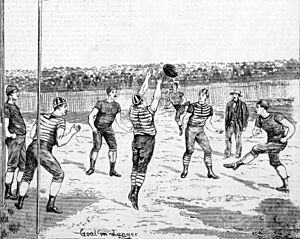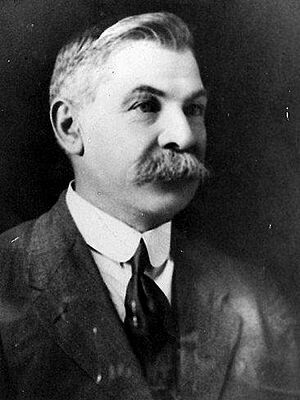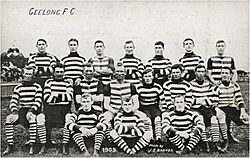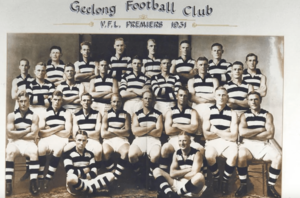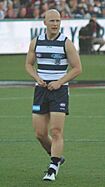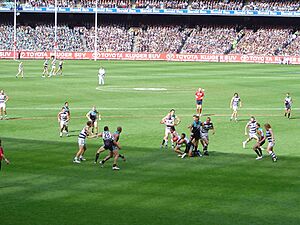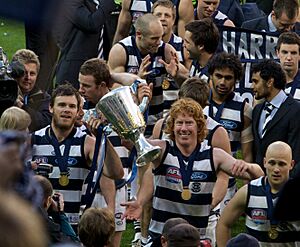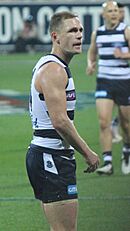History of the Geelong Football Club facts for kids
The Geelong Football Club has a long and exciting history, starting way back in 1859 in Geelong, Australia. It's one of the oldest football clubs in the world and the second oldest in the Australian Football League (AFL). The club is also one of the most successful!
At first, Geelong played by its own rules. Some of these rules, like the famous "running bounce," were later added to the official Australian Football rules. In the early 1860s, Geelong started playing under the main Laws of Australian Football after working with the Melbourne Football Club.
Geelong has almost always played in the top football competitions. They were a founding club of both the Victorian Football Association (VFA) in 1877 and the Victorian Football League (VFL) in 1897. Today, they continue to play in the elite Australian Football League (AFL). The team, known as the Cats, has won the VFL/AFL premiership ten times, with four of those wins happening since the AFL started in 1990. They also hold the record for the most McClelland Trophies, which are given to the team that finishes first on the ladder at the end of the regular season.
Contents
How Geelong Football Club Began
Football matches were played in Geelong as early as 1858. In April 1859, a local teacher named Mr. William "Stitt" Jenkins asked people to form an athletic club to play football. The creation of the Melbourne Football Club in May 1859 encouraged Geelong to start its own club.
The Geelong Football Club was officially formed at a meeting on 18 July 1859.
Historians believe Geelong's first rules were written by hand. These rules were a bit different from Melbourne's rules. For example, Geelong's rules didn't mention bouncing the ball, but they had a rule about "scrimmage" that was more like rugby football.
Geelong played its first game against another club, Melbourne, in 1860. It was a scoreless draw! These two clubs became big rivals early on. In 1862, Geelong introduced the "running bounce" rule. This meant players had to bounce the ball while running with it. Melbourne players, especially H. C. A. Harrison, were running too far without kicking or bouncing. Geelong felt the game was "not meant to be played like rugby." This bouncing rule was later made standard across Victoria in 1866.
Early Success and Key Players
Winning the Caledonian Cup
In 1863, Geelong traveled to Melbourne to play for the Caledonian Challenge Cup. Geelong won the cup, becoming the second team to do so. They then defended it twice to win the cup permanently in 1864.
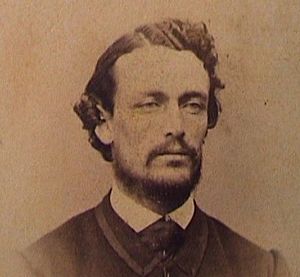
Tom Wills, one of the people who helped create Australian football, played for Geelong from 1865 until he retired in 1874. As Geelong's captain, he was one of the first to use a tactic called "flooding," where players move back to defend their goal.
Geelong played most of its early home games at Argyle Square. But in 1881, the club had to leave the ground because they hadn't paid rent.
Joining the VFA and Moving to Corio Oval
In 1877, the Victorian Football Association (VFA) was formed, and Geelong was one of the first clubs to join. The club moved its main home ground to Corio Oval in 1878. That same year, Geelong won its first VFA premiership! Over the next twenty years, Geelong became one of the strongest clubs in the VFA, winning seven premierships before the Victorian Football League (VFL) started in 1897.
In 1884, the club joined with the Geelong Cricket Club. This partnership lasted until the 1950s.
Geelong was the only team outside of Melbourne that regularly played against the city teams. A famous game was the "Match of the Century" in 1886, between undefeated Geelong and South Melbourne. People were so excited that some even tried to stop the special trains carrying Geelong fans!
The VFL Era Begins
New League, New Nickname
Geelong helped create the new VFL in 1897, along with other clubs like Carlton, Collingwood, and Melbourne.
For many years, the Geelong Football Club was called the Pivotonians, because Geelong city was known as 'The Pivot'. They were also called the Seagulls for a while. The dark blue and white striped uniform they still wear today represents the blue water of Corio Bay and the white seagulls that are common there.
The nickname 'Cats' came about in 1923. After a series of losses, a local cartoonist drew a picture suggesting the club needed a black cat for good luck. Geelong won their next game, and the captain, Bert Rankin, liked the idea. He suggested the club adopt "the Cats" as their nickname. They even had a player design a cat logo for badges! Geelong has been known as the 'Cats' ever since.
Even though Geelong was very strong in the VFA, winning premierships in the VFL was harder. In their first VFL season, Geelong finished second.
In 1924, the VFL created an award for the best and fairest player each season, named the Brownlow Medal after former Geelong leader Charles Brownlow. The very first player to win this award was Geelong's own Edward Greeves.
First VFL Premierships
Geelong finally won its first VFL premiership in 1925. They won two more premierships in 1931 and 1937. The 1937 Grand Final was known for its amazing kicking and high marks. During this time, there was a rule called the "Coulter Law" that stopped clubs from taking players from other teams. This was important because many players were only part-time athletes, and their football payments helped them during the Great Depression.
Challenges and Comebacks
World War II and a New Home
In 1941, the club had to leave Corio Oval because the military needed it for training during World War II. Geelong decided to move its home base to Kardinia Park in South Geelong, which was more central. The 1940s were tough for Geelong. Travel was restricted during the war, so players moved to other clubs. Geelong even had to stop playing for two years in 1942 and 1943.
Back-to-Back Premierships
| G | B | Total | |
|---|---|---|---|
| Geelong | 11 | 15 | 81 |
| Essendon | 10 | 10 | 70 |
| Venue (attendance) | |||
| Melbourne Cricket Ground (84,109) | |||
In 1949, former premiership captain Reg Hickey became coach again. Even though they missed the finals in his first year back, Hickey led Geelong to two premierships in a row in 1951 and 1952! These are the only back-to-back premierships in the club's history. Bernie Smith won the Brownlow Medal in 1951, becoming Geelong's second player to do so. That year, the club also got Ford Motor Company as a sponsor.
The 1951 Premiership was memorable. Essendon was expected to win, but their star player, John Coleman, was suspended and couldn't play in the Grand Final. Many believe if he had played, Essendon might have won.
| G | B | Total | |
|---|---|---|---|
| Geelong | 13 | 8 | 86 |
| Collingwood | 5 | 10 | 40 |
| Venue (attendance) | |||
| Melbourne Cricket Ground (82,890) | |||
To celebrate their wins, Geelong players had a funny tradition. After the 1937 premiership, they supposedly buried a magpie in the middle of Kardinia Park. After the 1951 win, they buried a toy bomber! In 1952, Geelong easily beat Lou Richards' Collingwood team. To celebrate, they buried another dead magpie! Famous players from this time included Bob Davis, Peter Pianto, and Fred Flanagan.
In 1956, Geelong recruited Billy Goggin, who became one of Geelong's greatest players and later coached the team. After the 1959 season, Reg Hickey retired, and Bob Davis took over as coach.
The 1963 Premiership
| G | B | Total | |
|---|---|---|---|
| Geelong | 15 | 19 | 109 |
| Hawthorn | 8 | 12 | 60 |
| Venue (attendance) | |||
| Melbourne Cricket Ground (101,452) | |||
Before the 1962 season, Bob Davis helped Geelong get star player Graham "Polly" Farmer. In 1963, the club won its sixth VFL premiership! They beat John Kennedy's Hawthorn team by 49 points in the Grand Final. After this win, a dead hawk was also buried under the Kardinia Park turf, joining the other buried items!
Sadly for fans, 1963 was the last time Geelong won a premiership until 2007.
In 1964, Geelong recruited John "Sammy" Newman, who went on to play 300 games for the club and became a well-known media personality. Geelong played in the finals every year between 1962 and 1969. Graham Farmer became captain in 1965. In 1967, Geelong reached the Grand Final but lost to Richmond.
Tough Times and New Talent
Searching for a Flag in the 70s and 80s
The 1970s were not very successful for Geelong. They only won one final during the whole decade. The club struggled to keep up with other teams that were becoming more professional. Richer clubs could pay more to get talented players, and Geelong couldn't always compete. Despite this, full-forward Larry Donohue kicked over 100 goals in 1976, becoming Geelong's third player to win the Coleman Medal.
In 1980, Billy Goggin returned to coach the team. They made the finals several times but couldn't win a premiership. After 1982, Tom Hafey became coach. He didn't lead Geelong to finals, but he helped recruit future stars like Gary Ablett, Paul Couch, and Greg Williams. In 1986, John Devine took over as coach. The club started to adapt to new league rules like the salary cap and the AFL Draft. They recruited players like Barry Stoneham, Garry Hocking, Mark Bairstow, and Billy Brownless. However, they still didn't make the finals.
The Blight Era and Grand Final Heartbreak
Four Grand Finals, No Flag
Malcolm Blight became coach, and Geelong quickly became known for scoring lots of points. In 1989, Geelong was the only club to win three games in a row by over 100 points! Their exciting style of play led them to their first Grand Final since 1967. However, they lost to Hawthorn by just six points in what was one of the greatest Grand Finals ever. Gary Ablett was amazing, kicking nine goals and winning the Norm Smith Medal for best on ground. Paul Couch also won the Brownlow Medal, Geelong's fourth Brownlow winner.
In 1990, Geelong couldn't repeat their exciting football. In 1991, Gary Ablett briefly retired but returned mid-season. Geelong made the finals, but Ablett was suspended and missed the rest of the season.
In 1992, Geelong was back to its spectacular form. They set a VFL/AFL record score of 37 goals and 17 behinds (239 points) against the Brisbane Bears. This record still stands today! Gary Ablett Sr. and Billy Brownless both kicked over 70 goals that season. Geelong finished first on the ladder. They reached the Grand Final again, playing against the West Coast Eagles. Geelong started well, leading by four goals, but West Coast came back to win by 28 points. It was the first premiership won by a non-Victorian club.
In 1993, Malcolm Blight tried more defensive tactics, and the team struggled. But when they went back to their attacking style, they played like champions again. Gary Ablett Sr. started playing permanently at full-forward and kicked over 100 goals, including 14 goals against Essendon!
1994 was another tough but successful year. Geelong finished fourth. They won a thrilling final against Footscray with a goal after the siren by Billy Brownless. They then beat Carlton, even though three of their best midfielders were injured. In the Preliminary Final against North Melbourne, Gary Ablett kicked the winning goal after the siren, sending Geelong to its third Grand Final in seven years!
Geelong played West Coast again in the Grand Final, but this time they lost by 80 points. Malcolm Blight resigned after three Grand Final losses. His assistant, Gary Ayres, took over.
In 1995, the club improved, finishing second on the ladder. Gary Ablett won the Coleman Medal again, kicking over 100 goals for the third year in a row. Geelong reached the Grand Final for the fourth time in seven years, playing against Carlton. But they played their worst game of the season and lost by 61 points. Paul Couch had another great year, almost winning his second Brownlow Medal.
A Period of Decline
In 1996, Geelong had a less successful year but still made the finals. Gary Ablett was suspended for five weeks and his form dropped, but he kicked his 1000th career goal. They lost to North Melbourne in the first week of finals. Garry Hocking won the Best and Fairest award and nearly won the Brownlow Medal. Steven King, a tall ruckman, was recruited.
In 1997, Geelong played without ageing stars like Paul Couch (who retired) and Gary Ablett (who was injured). They had a solid season, winning 15 games and finishing second. But they lost both their finals matches.
1998 was a very poor season, with Geelong finishing 12th, their lowest finish in over 40 years. However, they recruited Matthew Scarlett, the son of a former player, using the Father-Son Rule. This rule allows sons of ex-players to join their father's club.
In 1999, Geelong started strong, winning five games in a row, but then lost nine straight. Coach Gary Ayres left, and Mark Thompson was appointed coach. Geelong also traded Leigh Colbert for North Melbourne premiership player Cameron Mooney.
A New Era of Success
Thompson's Rebuild and New Stars
Mark Thompson's first season in 2000 was good. Geelong finished fifth and made the finals, but lost to Hawthorn. After the AFL reserves competition ended, Geelong started fielding a reserves team in the Victorian Football League (VFL) from 2000.
The next three years were tough, with Geelong missing the finals. However, they recruited some amazing young players. In the 2001 AFL Draft, they picked future premiership stars Jimmy Bartel, James Kelly, Steve Johnson, and Gary Ablett Jr. (who joined under the father-son rule). In 2002, Geelong's reserves team won its first VFL premiership.
Geelong returned to the finals in 2004, reaching the preliminary finals but losing to Brisbane. They also recruited Nathan Ablett (Gary Jr.'s brother) and Brad Ottens, who would be very important in future premierships.
In 2005, Geelong made the semi-finals. They were leading Sydney by 23 points in the final quarter, but Sydney's Nick Davis kicked four late goals, including one just before the siren, to win by three points. Sydney then went on to win the Grand Final.
After winning the 2006 pre-season competition, Geelong had a poor regular season, finishing tenth and missing the finals.
Ending the Premiership Drought
The 2007 season started slowly for Geelong. After five rounds, they were tenth on the ladder. Player Paul Chapman spoke out, saying the team needed to change its attitude. This led to a big team discussion, which turned things around. Geelong then won 15 games in a row! They finished first on the ladder, winning their first McLelland Trophy since 1992.
Geelong then won their qualifying and preliminary finals, reaching the 2007 AFL Grand Final. They played Port Adelaide and won by a record margin of 119 points! Geelong scored 24 goals and 19 points (163 points), while Port Adelaide scored only 6 goals and 8 points (44 points). Steve Johnson won the Norm Smith Medal for best on ground. This was Geelong's first premiership since 1963, ending a 44-year drought. The club's VFL team also won its premiership the weekend before!
| G | B | Total | |
|---|---|---|---|
| Geelong | 24 | 19 | 163 |
| Port Adelaide | 6 | 8 | 44 |
| Venue (attendance) | |||
| Melbourne Cricket Ground (97,302) | |||
In 2008, Geelong officially changed its name to the Geelong Cats. They continued to dominate, winning 21 out of 22 regular season games. They finished first again, winning their ninth McClelland Trophy. They reached the 2008 AFL Grand Final but lost to Hawthorn by 26 points.
| G | B | Total | |
|---|---|---|---|
| St Kilda | 9 | 14 | 68 |
| Geelong | 12 | 8 | 80 |
| Venue (attendance) | |||
| Melbourne Cricket Ground (99,251) | |||
Geelong started 2009 strongly, winning their first 13 games. They beat Hawthorn in a thrilling game where Jimmy Bartel kicked a point after the siren to win. Geelong finished with 18 wins and 4 losses. They reached the 2009 AFL Grand Final against St Kilda and won by 12 points!
This was the first time since 1984 that a Grand Final was won by a team that was behind at every break. Paul Chapman won the Norm Smith Medal. During this successful time, Geelong also had two Brownlow Medallists: Jimmy Bartel (2007) and Gary Ablett, Jr. (2009). Gary Ablett Jr. also won the Leigh Matthews Trophy as the AFL Players Association's Most Valuable Player three times in a row.
In 2010, Geelong finished second but didn't reach the Grand Final. After the season, Gary Ablett Jr. left to join the new Gold Coast team. He signed a very big contract that Geelong couldn't match. Less than a week later, coach Mark Thompson resigned, saying he was burnt out.
Scott Takes Over and More Flags
| G | B | Total | |
|---|---|---|---|
| Collingwood | 12 | 9 | 81 |
| Geelong | 18 | 11 | 119 |
| Venue (attendance) | |||
| Melbourne Cricket Ground (99,537) | |||
After Thompson left, former Brisbane player Chris Scott became the new coach. Even though many thought the team was getting old, Geelong finished second in 2011 with only three losses. They won their first two finals and reached the 2011 AFL Grand Final against Collingwood. Geelong won by 38 points, claiming their third premiership in five seasons and their ninth VFL/AFL premiership overall! Jimmy Bartel won his second Norm Smith Medal. Interestingly, all three of Collingwood's losses that season were to Geelong. Captain Cameron Ling retired after this win, and Joel Selwood became the new captain in 2012.
Geelong couldn't defend their premiership in 2012, losing their first final. Some people thought this was the end of Geelong's successful era. However, Geelong's reserves team won its third VFL premiership that year.
Geelong made the finals again in 2013 and 2014. In 2013, Kardinia Park hosted a finals match for the first time, but Geelong lost.
In 2015, a match between Adelaide and Geelong was cancelled and declared a draw after the death of Adelaide coach Phil Walsh. This was the first time a match had been abandoned in VFL/AFL history.
Recruiting for Continued Success
After missing the finals in 2015, Geelong worked hard to recruit new players. They brought in established AFL stars like Patrick Dangerfield (from Adelaide), Lachie Henderson (Carlton), Scott Selwood (West Coast), and Zac Smith (Gold Coast). This was to help the team get back to premiership contention.
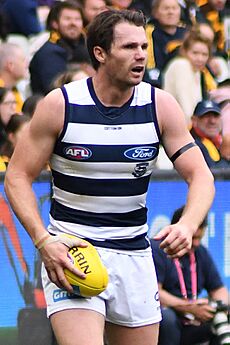
Many premiership players had retired or moved to other clubs, so these new recruits were important.
Geelong improved a lot in 2016, finishing second and reaching the preliminary finals. Corey Enright broke the club's all-time games record, playing his 326th game. Jimmy Bartel also played his 300th game. In his first season at Geelong, Patrick Dangerfield won the 2016 Brownlow Medal with a record 35 votes!
In 2017, Geelong reached the preliminary finals again but lost to Adelaide. The next year, Gary Ablett Jr. returned to Geelong after playing seven seasons for Gold Coast. In 2018, Geelong finished eighth and lost their first final.
The 2019 season saw Geelong finish on top of the AFL ladder for the first time since 2008. They won 11 of their first 12 games. They reached the preliminary final but lost to Richmond.
In the 2020 season, which was affected by COVID-19, Geelong finished fourth. They lost their first final but then won two big games to reach their first Grand Final in nine years! However, they lost to Richmond despite leading at half-time. This was Gary Ablett Jnr's last game, and he played through a shoulder injury, leaving the field to a guard of honor from both teams.
In 2021, Geelong finished third and reached another preliminary final, but they lost badly to Melbourne.
Geelong has also been granted a license to have a women's team in the AFL Women's (AFLW) competition starting in 2019. They have also played in the VFL Women's competition since 2017.
Cats End Finals Hoodoo and Win 10th Premiership
| G | B | Total | |
|---|---|---|---|
| Geelong | 20 | 13 | 133 |
| Sydney | 8 | 4 | 52 |
| Venue (attendance) | |||
| Melbourne Cricket Ground (100,024) | |||
Geelong had a shaky start to their 2022 season, with five wins and four losses. But then, the Cats didn't lose another game for the rest of the season! This included a close qualifying final win over Collingwood, a huge preliminary final win over Brisbane, and a Grand Final triumph over Sydney. This win gave the Cats their 10th premiership and Chris Scott his second as coach. Geelong started the Grand Final strongly, leading by a lot at quarter time, and cruised to an 81-point victory. Isaac Smith won the Norm Smith Medal.
See also
- List of Geelong Football Club seasons
- 1963 Miracle Match


